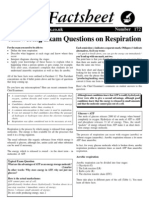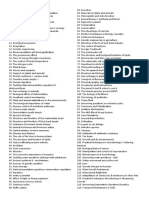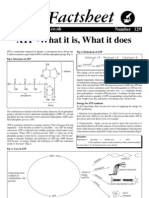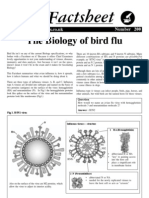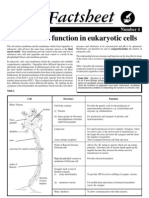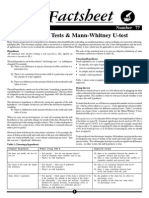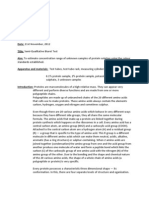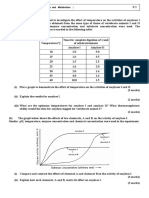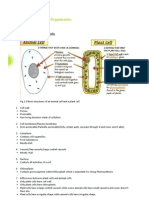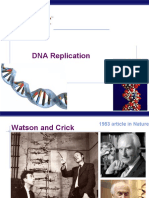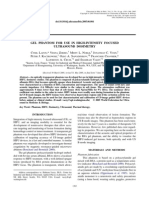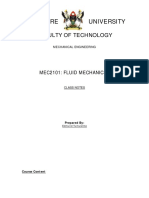Respiration
Respiration
Uploaded by
Bio SciencesCopyright:
Available Formats
Respiration
Respiration
Uploaded by
Bio SciencesOriginal Description:
Copyright
Available Formats
Share this document
Did you find this document useful?
Is this content inappropriate?
Copyright:
Available Formats
Respiration
Respiration
Uploaded by
Bio SciencesCopyright:
Available Formats
1
Respiration
Aerobic respiration can be divided into four stages:
1. Glycolysis (G)
2. The Link reaction (LR)
3. Krebs cycle (K)
4. The electron transfer chain (ETC)
These take place in different parts of the cell (Table 1) and the detailed
biochemistry of these reactions is shown overleaf.
Respiratory quotients
The respiratory quotient (RQ) is defined as the ratio of carbon dioxide
produced to oxygen consumed per unit time by an organism:
volume of CO
2
produced
volume of O
2
consumed
Different substances give different RQ values
Cellular respiration is the process by which the energy contained in organic molecules is made available for all of the active
processes within a cell. The usual substrate (the organic substance from which energy is released) is glucose, although fats, amino
acids and other substrates can be used if necessary. The energy which is released is stored - in the short term - in molecules of ATP.
The process of respiration can occur with oxygen (aerobic) or without oxygen (anaerobic). For every glucose molecule which is
broken down, aerobic respiration produces nineteen times as much ATP than anaerobic respiration.
Anaerobic respiration
If oxygen is unavailable the Krebs cycle and electron transfer chain
cannot operate. This is because without oxygen there would be no
way of disposing of the hydrogen at, for example, the end of the
electron transfer chain. However, even in anaerobic conditions,
glycolysis occurs so reduced NAD still forms. If glycolysis is to
continue, the reduced NAD must be reoxidized, that is, the hydrogen
must be removed and disposed of. Anaerobic organisms have
developed two ways of doing this:
1. In yeast, pyruvate is decarboxylated to produce ethenal. Ethenal
then accepts the hydrogen from NAD and forms ethanol. This
releases the NAD to be reused in glycolysis. The conversion of
pyruvic acid to ethanol with the release of carbon dioxide is called
alcoholic fermentation.
2. In mammals, the pyruvate accepts the hydrogen from NAD and
is reduced to lactate. The NAD is then available for further use
in glycolysis. If oxygen later becomes available, the lactate is
reoxidised.
Since anaerobic respiration only involves glycolysis, only the 2 ATP
produced in glycolysis are formed.
Table 1. Summary box of cellular respiration
Stage Site Oxygen
Needed?
What Happens? Net ATP production
per glucose molecule
Glycolysis Cytoplasm No Glucose is converted to pyruvic acid. Hydrogen
is removed and is passed to the electron carriers.
2
Link Reaction Matrix of
Mitochondria
Yes Pyruvate enters mitochondrion, is
decarboxylated, dehydrogenated and combines
with coenzyme A to give acetyl coenzyme A.
The hydrogen which is removed is passed to the
electron carriers.
Krebs Cycle Matrix of
Mitochondria
Yes A cyclical series of reactions during which
hydrogen is passed to the electron carriers,
carbon dioxide is removed and the starting
reagents are regenerated.
2
ETC. Crista of Inner
Membrane of
Mitochondria
Yes The hydrogen from glycolysis and Krebs cycle
is split to release electrons. These pass through
carriers and generate ATP. The hydrogen
reforms and is combined with oxygen to release
water.
34
Substrate
Glucose
Amino Acids
Triglyceride (fat)
RQ
0.9
0.7
1
per unit time.
RQ =
Respiration
2
2ATP used
Glucose HB (6C) 2TP (3C) 2PA (3C)
2 1 3
4
2H
9
NADH/FADH
2
NAD /FAD
2NAD
2H
4ATP
Glycolysis - occurs in the cell cytoplasm in both aerobic and anaerobic conditions.
1. Glucose is phosphorylated, i.e. ATP is used to add a phosphate group to glucose. This
makes the glucose more reactive, allowing it to be broken down. A six carbon (6C)
phosphorylated sugar is produced called hexose bisphosphate.
2. The hexose bisphosphate is converted into two molecules of a 3C sugar phosphate called
Triose Phosphate (TP)
3. Hydrogen is removed from each of the TP molecules, i.e. the TP molecules are oxidised.
The hydrogen is passed to NAD, a coenzyme which, by definition, is said to be reduced.
Remember - any substance that gains oxygen or loses hydrogen or electrons is said to be
oxidised. Any substance that loses oxygen or gains hydrogen or electrons is said to be
reduced. The enzymes which remove hydrogen from substances are called
dehydrogenases. The hydrogen atoms picked up by NAD are used to generate four
molecules of ATP. The removal of hydrogen from TP produces pyruvic acid (PA).
The Link Reaction - occurs only if oxygen is available.
4. PA enters the mitochondrion
5. Carbon dioxide and hydrogen are removed from the PA by decarboxylase and
dehydrogenase enzymes respectively. The PA is combined with coenzyme A (CoA) to form
a 2C compound called acetylcoenzyme A (AcCoA).
Kreb's Cycle - only occurs if oxygen is available.
5. AcCoA (2C) is combined with oxaloacetate (4C) to form citrate (6C). Citrate enters the
Krebs cycle. This involves a series of decarboxylation and dehydrogenation reactions.
6. The carbon dioxide is released. The hydrogen which is removed is passed to coenzymes
such as NAD and FAD (i.e. the coenzymes are reduced).
7. 2ATP molecules are generated directly in the Krebs cycle.
8. Eventually the 4C compound (oxaloacetate) is regenerated. This then combines with more
AcCoA and the whole cycle begins again.
The electron transfer chain - only occurs if oxygen is available.
9. The reduced coenzymes NAD and FAD are reoxidized, i.e. hydrogen is removed from
them by dehydrogenase enzymes located on the cristi of the inner membrane of the
mitochondrion.
10. Each hydrogen atom is split into a hydrogen ion (H
+
) and an electron (e
-
).
11. The electrons then pass through a series of electron carriers. Just as in the electron
transfer chain in the light-dependent stage of photosynthesis (see Factsheet 2), the electron
carriers are at successively lower energy levels. As the electron passes down from one
electron carrier to another, some of their energy is released. This energy is used to convert
ADP into ATP, i.e. to phosphorylate ADP. Since the removal of hydrogen or electrons from
substance is defined as oxidation, the overall reactions of the ETC are known as oxidative
phosphorylation.
12. Finally, each electron is reunited with a hydrogen ion (H
+
) and the hydrogen which forms
immediately combines with oxygen to form water.
KEY
HB Hexose Bisphosphate
TP Triose Phosphate
NAD Nicotinomide Adenine
Dinucleotide
PA Pyruvic Acid
CoA Coenzyme A
AcCoA Acetylcoenzyme A
FAD Flavin Adenine Dinucleotide
H
+
Hydrogen ion
e
-
Electron
ADP Adenosine Diphosphate
ATP Adenosine Triphosphate
iP Inorganic Phosphate
5
8
7
ADP + iP
ATP
6
citrate (6C)
AcCoA (2C) CoA
2H
CO
2
5
CO
2
Oxaloacetate (4C)
e
-
carrier
H
+
+ e
-
e
-
carrier
e
-
carrier
4e
-
+ 4H
+
+ O
2
2H
2
O
e
n
e
rg
y
e
n
e
rg
y
ADP + iP
ATP
10
ADP + iP
ATP
11
12
Exam Hint - When learning the fine
detail you must practice drawing the
stages out until you can do it without
looking at the Factsheet. But, dont forget
the overall point of respiration - to make
energy available from glucose.
Remember GCSE;
Glucose + O
2
CO
2
+ H
2
O + energy
You are simply learning about each of
these in more detail!
Respiration
3
Practice questions
1. The diagram shows some of the stages in glycolysis:
Glucose
Hexose phosphate
Hexose biphosphate
Triose phosphate
Pyruvate
(a) Identify substances:
(i) X (1 mark)
(ii) Y (1 mark)
(b) Explain why anaerobic breakdown of glucose is much less
efficient than aerobic breakdown. (4 marks)
2. Differentiate between oxidative photophosphorylation and oxidative
phosphorylation. (2 marks)
3. Carefully read the following account of aerobic respiration and then
fill in the blanks.
In the first stage of respiration which occurs in the .............. of the cell,
glucose is .
to pyruvic acid. Glycolysis yields .............. and reduced
coenzyme. The pyruvic acid then combines with coenzyme A to form
which enters the Kreb's cycle which occurs in the ............... of the
During these reactions hydrogen atoms are removed from a
series of intermediate compounds by enzymes called .................... The
hydrogen atoms are passed to carriers such as .
.......................................................... . In the third
stage of aerobic respiration, the carriers are alternately reduced
and.
as they gain and lose electrons. Energy is released and
used to phosphorylate ADP forming.
............................................. The hydrogen atoms
finally combine with ................. to form .................
(12 marks)
4. The diagram shows some of the stages of anaerobic respiration in a
muscle.
Glucose Pyruvate Y ethanol
(a) Identify process X (1 mark)
(b) Where in the cell does this process occur?
(1 mark)
(c) Identify substance Y (1 mark)
(d) What is the role of substance Y in this process? (1 mark)
Y
X
X
ProcessX
2H
Answers
Marking points are indicated by semicolons.
1. (a) (i) ATP;
(ii) hydrogen/hydrogen ions;
(b) Without oxygen, ETC and Kreb's cannot continue;
Because no hydrogen acceptor;
Only ATP production is from glycolysis;
Net production in anaerobic is 2ATP, but from aerobic is 38
ATP per molecule of glucose;
2. Oxidative photophosphorylation occurs in LDS of photosynthesis;
in chloroplast;
Oxidative phosphorylation occurs in ETC of respiration;
in mitochondria;
3. cytoplasm;
oxidised;
ATP;
Acetylcoenzyme A;
matrix;
mitochondria;
dehydrogenases;
NAD/FAD;
oxidised;
ATP;
oxygen;
water;
4. (a) glycolysis;
(b) cytoplasm;
(c) ethanal;
(d) Accept hydrogen from NAD/reoxidise NAD;
Z
Reduced Z
You might also like
- Chemistry For Engineers Course SyllabusDocument8 pagesChemistry For Engineers Course SyllabusAce Heart Rosendo Amante100% (1)
- CarbohydratesDocument48 pagesCarbohydratesBio SciencesNo ratings yet
- Natural Selection WorksheetDocument2 pagesNatural Selection WorksheetSabrina ChangNo ratings yet
- 12 RespirationDocument3 pages12 RespirationSan Siddz100% (1)
- Bio Factsheet: Answering Exam Questions On RespirationDocument4 pagesBio Factsheet: Answering Exam Questions On Respirationapi-213276898No ratings yet
- List of Biology Fact SheetsDocument3 pagesList of Biology Fact Sheetsgert160% (1)
- A227 RuBP CarboxylaseDocument4 pagesA227 RuBP Carboxylaseramloghun veer100% (1)
- Module 6 in BiochemistryDocument19 pagesModule 6 in BiochemistryjeromeNo ratings yet
- Nucleic AcidsDocument3 pagesNucleic AcidsBio Sciences100% (2)
- Exam Stress ManagementDocument31 pagesExam Stress ManagementBio Sciences90% (10)
- Experiment 8 PDFDocument3 pagesExperiment 8 PDFKartik BhararaNo ratings yet
- Cellular RespirationDocument58 pagesCellular Respirationridzwan1991No ratings yet
- ATP - What It Is, What It Does: Bio FactsheetDocument2 pagesATP - What It Is, What It Does: Bio FactsheetCamila KrugNo ratings yet
- Viruses Made SimpleDocument4 pagesViruses Made Simplelastjoe7167% (3)
- Bio Factsheet: EvolutionDocument3 pagesBio Factsheet: EvolutionsreenitthiNo ratings yet
- Feedback Control MechanismsDocument4 pagesFeedback Control MechanismsJividan SasidranNo ratings yet
- Classification of Carbonyl and Hydroxyl Containing CompoundsDocument7 pagesClassification of Carbonyl and Hydroxyl Containing CompoundsSamantha Hope SyNo ratings yet
- 022 - Protein Synthesis I - Nucleic AcidsDocument3 pages022 - Protein Synthesis I - Nucleic Acidslastjoe71100% (1)
- Chloroplasts Structure and Function FactsheetDocument4 pagesChloroplasts Structure and Function Factsheettapas kundu100% (1)
- 094 GeneDocument4 pages094 GenealchimaNo ratings yet
- A224 Why We Need Biodiversity MedicineDocument3 pagesA224 Why We Need Biodiversity Medicineramloghun veerNo ratings yet
- Bio Factsheet 78 Chemical Bonding in Biological Molecules PDFDocument4 pagesBio Factsheet 78 Chemical Bonding in Biological Molecules PDFOmarKoiyNo ratings yet
- Antibiotic Use and The Rise of Clostridium DifficileDocument3 pagesAntibiotic Use and The Rise of Clostridium Difficilelastjoe71No ratings yet
- A223 ChemiosmosisDocument4 pagesA223 Chemiosmosisramloghun veer100% (1)
- 159 PolysaccharidesDocument4 pages159 PolysaccharidesHAMZAHwozERE100% (2)
- Transport Mechanisms in CellsDocument4 pagesTransport Mechanisms in Cellsd_94No ratings yet
- Captive Breeding and The Role of Zoos PDFDocument5 pagesCaptive Breeding and The Role of Zoos PDFTamicka BonnickNo ratings yet
- 189 Climate ChangeDocument4 pages189 Climate ChangeKaren FuNo ratings yet
- 048 - Tackling Exam Questions - Plant Growth SubstancesDocument3 pages048 - Tackling Exam Questions - Plant Growth Substanceslastjoe71No ratings yet
- Bio Factsheet: The Biology of HIVDocument3 pagesBio Factsheet: The Biology of HIVAriful IslamNo ratings yet
- 86 Human Genome ProjectDocument3 pages86 Human Genome ProjectDebbieJonesNo ratings yet
- Ischaemic (Coronary) Heart DiseaseDocument4 pagesIschaemic (Coronary) Heart DiseasePrabhathNo ratings yet
- Dominant and Recessive AllelesDocument3 pagesDominant and Recessive AllelesDanny Siloka100% (1)
- 44 EvolutionDocument3 pages44 EvolutionBritanny Bri-Bri RobertsNo ratings yet
- Data Interpretation Questions - Temperature RegulationDocument4 pagesData Interpretation Questions - Temperature Regulationtristan reidNo ratings yet
- 39 Carbohydrates PDFDocument3 pages39 Carbohydrates PDFfaryal khan100% (1)
- Xerophytes and HydrophytesDocument3 pagesXerophytes and Hydrophytespaulas2014No ratings yet
- Mammalian Heart PDFDocument5 pagesMammalian Heart PDFKhaled TurkNo ratings yet
- 032 - Viruses Made SimpleDocument4 pages032 - Viruses Made SimpleRayonesh RayanaNo ratings yet
- Answering Exam Questions: Classification and Keys: Number 170 WWW - Curriculum-Press - Co.ukDocument4 pagesAnswering Exam Questions: Classification and Keys: Number 170 WWW - Curriculum-Press - Co.ukIlincaVasilescu0% (1)
- Answering Exam Questions On CellsDocument4 pagesAnswering Exam Questions On CellsTamicka Bonnick100% (1)
- 200 Bird - FluDocument6 pages200 Bird - FluSue Adames de VelascoNo ratings yet
- 1.3 Cell Membranes (Main)Document53 pages1.3 Cell Membranes (Main)MeryemNo ratings yet
- 04 Structure To FunctionDocument5 pages04 Structure To Function897291868100% (1)
- Bio Factsheet 296 Diesel FumesDocument3 pagesBio Factsheet 296 Diesel FumesSue Adames de VelascoNo ratings yet
- Calculating Water Potential Worksheet-2012 2Document4 pagesCalculating Water Potential Worksheet-2012 2aemilianne100% (1)
- Classification StudysheetDocument36 pagesClassification Studysheetwafa elias100% (1)
- Ecology PDFDocument3 pagesEcology PDFAlyssa AshbyNo ratings yet
- 16 Flow of EnergyDocument2 pages16 Flow of Energyramloghun veerNo ratings yet
- A258 Cereals C4 PlantsDocument5 pagesA258 Cereals C4 Plantsramloghun veerNo ratings yet
- Hypothesis Tests & Mann-Whitney U-TestDocument2 pagesHypothesis Tests & Mann-Whitney U-Testlastjoe71No ratings yet
- 173 Food Tests and ChromatographyDocument3 pages173 Food Tests and Chromatographykpb6261No ratings yet
- Photosynthesis Worksheet 2 KeyDocument7 pagesPhotosynthesis Worksheet 2 KeysarfarazNo ratings yet
- Biology Lab - Biuret TestDocument7 pagesBiology Lab - Biuret TestZoe Bradshaw0% (1)
- 179 - Answering Exam Questions - MutationDocument3 pages179 - Answering Exam Questions - MutationKakar BloonNo ratings yet
- Chapter4 - Enzyme and MetabolismDocument10 pagesChapter4 - Enzyme and MetabolismBilly Lam100% (1)
- Lecture Notes On Cellular RespirationDocument16 pagesLecture Notes On Cellular RespirationBhillee Agas ValdezNo ratings yet
- 4.4 RespirationDocument4 pages4.4 Respirationsmithsashay74No ratings yet
- Module 3C - Cellular RespirationDocument9 pagesModule 3C - Cellular RespirationDiane Balaba OsingNo ratings yet
- Topic 5 RespirationDocument11 pagesTopic 5 RespirationPriya Kumar100% (1)
- Cellular RespirationDocument3 pagesCellular RespirationErnest Nuñez LoquinarioNo ratings yet
- Cellular RespirationDocument3 pagesCellular RespirationErnest Nuñez LoquinarioNo ratings yet
- A Level Biology T1W5Document34 pagesA Level Biology T1W5old boyNo ratings yet
- Las Q4 WK3.1Document8 pagesLas Q4 WK3.1Perlyn Del Pilar OduyaNo ratings yet
- Comparing Transport in Plants & AnimalsDocument2 pagesComparing Transport in Plants & AnimalsBio SciencesNo ratings yet
- Deforestation PDFDocument2 pagesDeforestation PDFBio SciencesNo ratings yet
- Biology Notes For O LevelDocument36 pagesBiology Notes For O LevelAhmad Barrun Nidhom92% (158)
- The Greenhouse Effect: EXAM HINT - Candidates Often Confuse TheDocument3 pagesThe Greenhouse Effect: EXAM HINT - Candidates Often Confuse TheBio SciencesNo ratings yet
- Cell BiologyDocument52 pagesCell BiologyDefensor Pison GringgoNo ratings yet
- ProteinBasics MaureenHillenmeyerDocument101 pagesProteinBasics MaureenHillenmeyerPersis Priya HarrisNo ratings yet
- Population DynamicsDocument32 pagesPopulation DynamicsBio SciencesNo ratings yet
- DNA Replication: AP BiologyDocument35 pagesDNA Replication: AP BiologyFatemeh HalabizNo ratings yet
- Introduction To World of BiologyDocument61 pagesIntroduction To World of BiologyBio SciencesNo ratings yet
- Chemistry of LipidsDocument92 pagesChemistry of LipidsSumit Tated100% (2)
- Principles of ClassificationDocument70 pagesPrinciples of ClassificationBio Sciences50% (2)
- Biology: What Is The Study of Life?Document13 pagesBiology: What Is The Study of Life?Bio SciencesNo ratings yet
- Biology IntroductionDocument66 pagesBiology IntroductionBio SciencesNo ratings yet
- Exam Study Strategies PresentationDocument27 pagesExam Study Strategies PresentationBio SciencesNo ratings yet
- Shark ConservationDocument42 pagesShark ConservationBio Sciences100% (3)
- Shark PowerpointDocument12 pagesShark PowerpointBio SciencesNo ratings yet
- ProcrastinationDocument25 pagesProcrastinationBio Sciences100% (3)
- Taenia SoliumDocument40 pagesTaenia SoliumBio SciencesNo ratings yet
- Reptiles ContdDocument23 pagesReptiles ContdBio SciencesNo ratings yet
- DR P. Ramesh Babu: BY K. Kishore Kumar Under The Guidance ofDocument54 pagesDR P. Ramesh Babu: BY K. Kishore Kumar Under The Guidance ofSharath Reddy BommineniNo ratings yet
- Berkley B3ZPL PumpDocument24 pagesBerkley B3ZPL PumpPumpxpertNo ratings yet
- Coleman2014 PDFDocument12 pagesColeman2014 PDFNguyen TriNo ratings yet
- Unit Operation: What Is Chemical Engineering?Document5 pagesUnit Operation: What Is Chemical Engineering?Priyanka DeuriNo ratings yet
- Colligative Property Freezing Point DepressionDocument4 pagesColligative Property Freezing Point DepressionJoon Bok NamleeNo ratings yet
- Problem 12.43: Given: Find: SolutionDocument1 pageProblem 12.43: Given: Find: SolutionSylton D. Lima100% (1)
- Catalog Precisa PDFDocument27 pagesCatalog Precisa PDFmbilalk315No ratings yet
- Universiti Teknologi Mara: Analytical Chemistry TEST2 / MAY 2020/CHM421Document2 pagesUniversiti Teknologi Mara: Analytical Chemistry TEST2 / MAY 2020/CHM421Erna HamidNo ratings yet
- Gel Phantom in Ultrasound DosimetryDocument7 pagesGel Phantom in Ultrasound DosimetrytomgrgicNo ratings yet
- Retrofitting Technology: Seminar OnDocument26 pagesRetrofitting Technology: Seminar OnVarun Rai100% (1)
- Cryogenic Heat TreatmentDocument3 pagesCryogenic Heat Treatmentsri78770% (1)
- Q1 Science Tos CRT Melc BasedDocument7 pagesQ1 Science Tos CRT Melc BasedShaharaZ.Mendoza-PañaresNo ratings yet
- Analytical Chemistry LabDocument5 pagesAnalytical Chemistry Labhgg uiNo ratings yet
- Fluids Notes 1,2.3Document46 pagesFluids Notes 1,2.3Tobias Okoth100% (1)
- MiniDocument4 pagesMinicitramuaraNo ratings yet
- Atomic Emission Spectroscopy AsdaDocument18 pagesAtomic Emission Spectroscopy AsdaMark Cliffton BadlonNo ratings yet
- GATE Chemical Engineering 2003Document12 pagesGATE Chemical Engineering 2003anand singhNo ratings yet
- Fds Yuasa Sds Automotive Wet Flooded1Document10 pagesFds Yuasa Sds Automotive Wet Flooded1letorotoNo ratings yet
- How To Design PrimersDocument14 pagesHow To Design PrimersDeepak RawoolNo ratings yet
- Jurnal Produksi Dan Pemurnian Asam GlutamatDocument13 pagesJurnal Produksi Dan Pemurnian Asam GlutamatMaylinna Sarah LukythaNo ratings yet
- Conbextra EBGMDocument3 pagesConbextra EBGMAnonymous XVEucVMsENo ratings yet
- Pre-Board Term - I Examination SCIENCE (086) PB-I-2021-10: General InstructionsDocument17 pagesPre-Board Term - I Examination SCIENCE (086) PB-I-2021-10: General InstructionsVVS. G.S1074No ratings yet
- Tutorial 1 Phy250Document9 pagesTutorial 1 Phy250Muhammad AziziNo ratings yet
- Nylon Plastics by M. I. Kohan P. 474-475Document1 pageNylon Plastics by M. I. Kohan P. 474-475Guery SaenzNo ratings yet
- 1 - Pengantar Reaktor KimiaDocument16 pages1 - Pengantar Reaktor KimiaRyrynArianyNo ratings yet
- Atoms Molecules and StoichiometryDocument28 pagesAtoms Molecules and StoichiometrySharneeshriyaNo ratings yet
- Blood Physio Lab 2Document3 pagesBlood Physio Lab 2Omer AlsameiNo ratings yet
- CPD/VRF PresentationDocument23 pagesCPD/VRF PresentationthibinNo ratings yet




